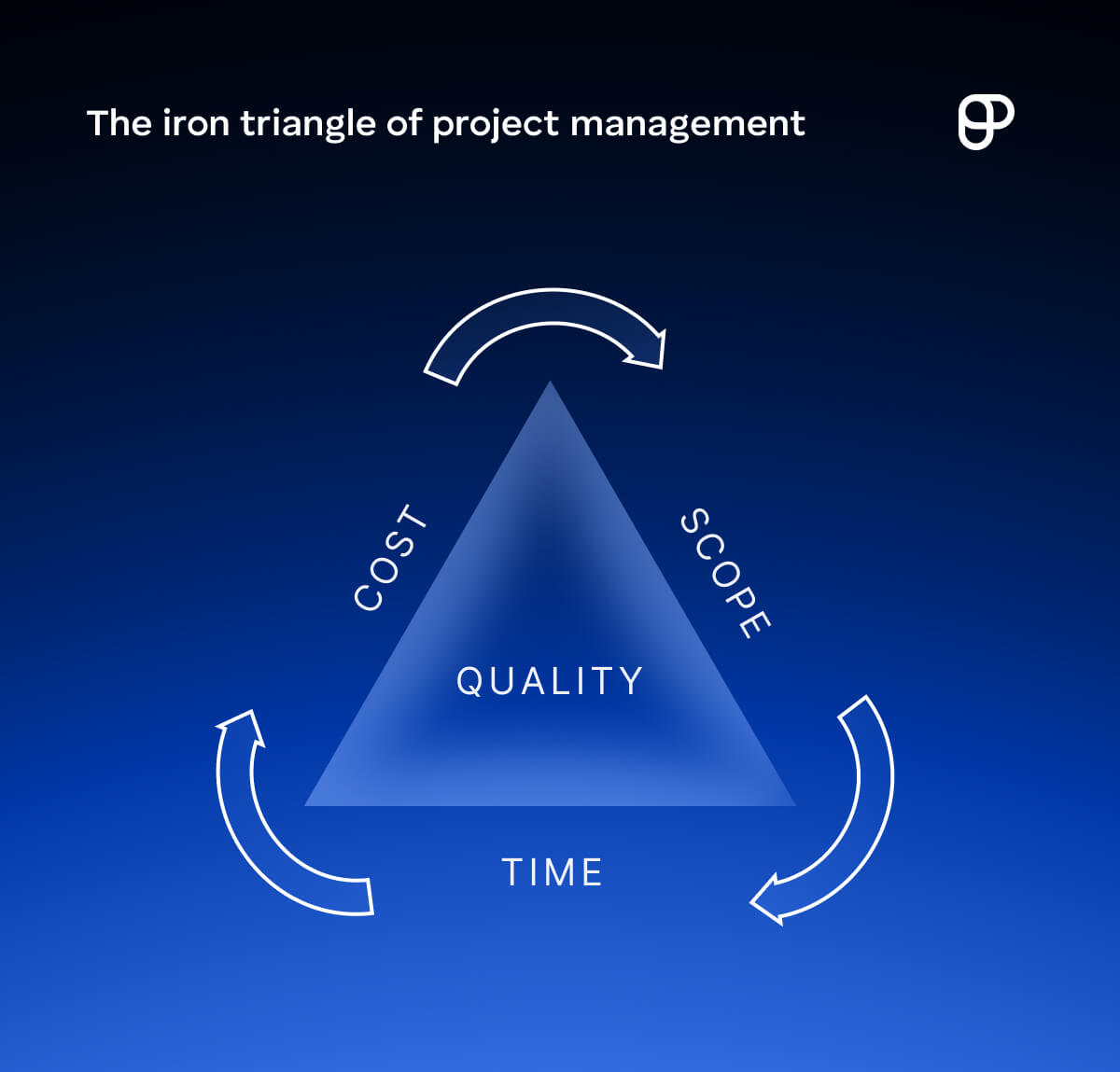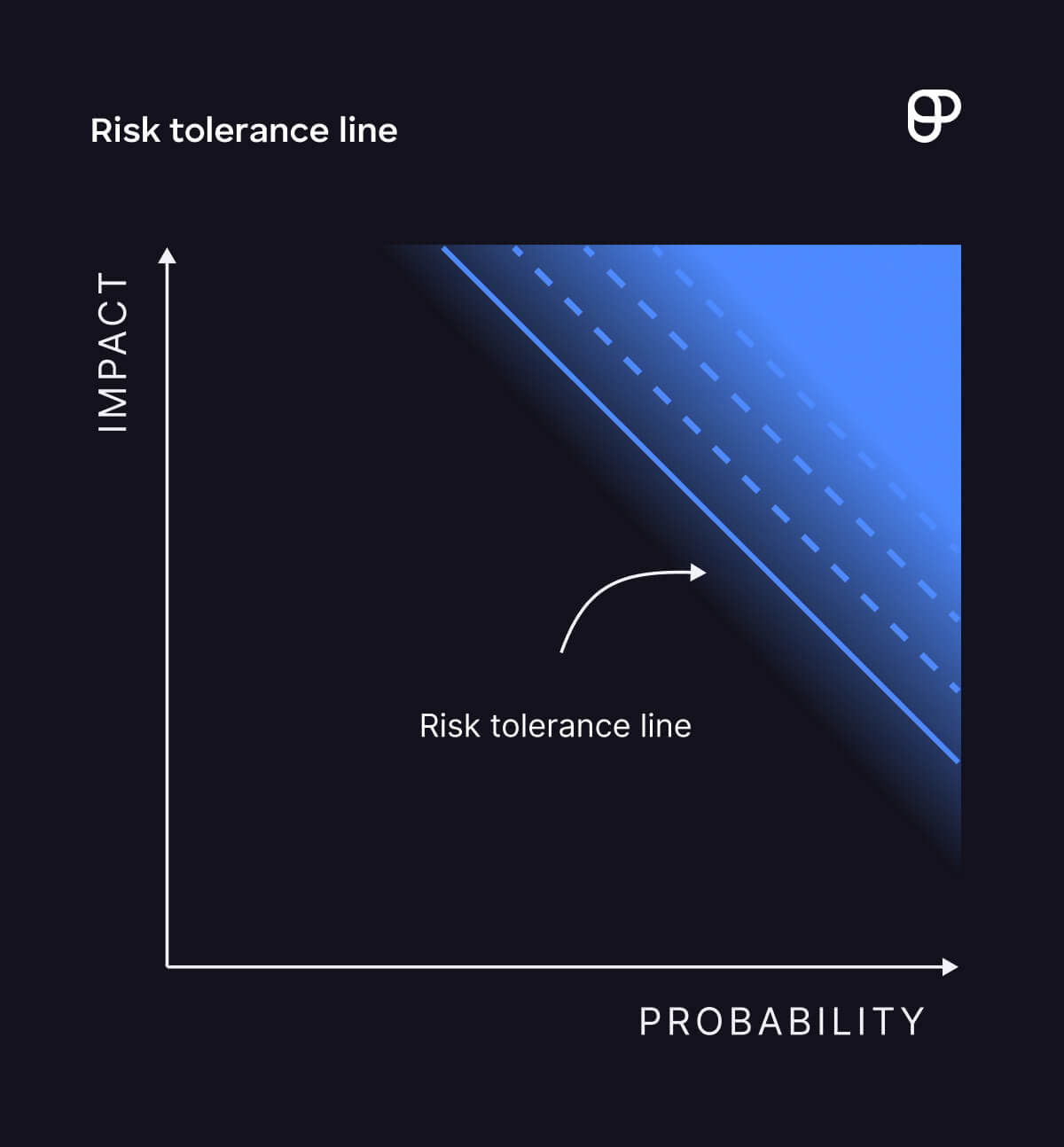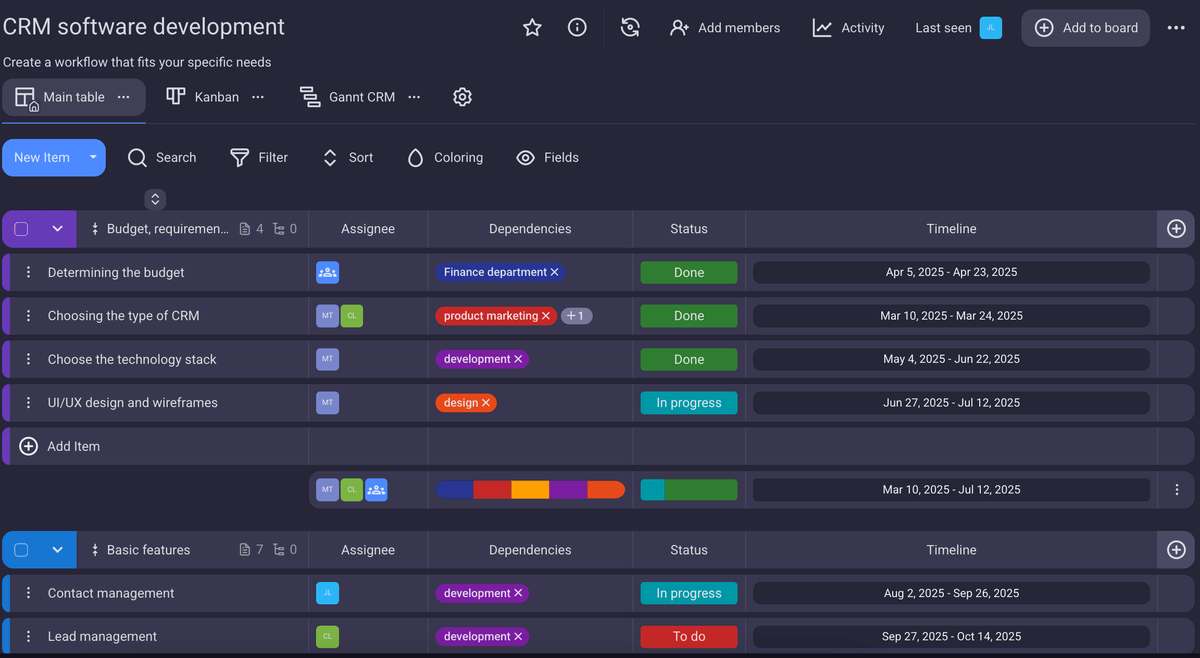Every project faces constraints — the only difference from one to another is how limiting they are.
Usually, project managers are experts in delivering a successful project on time and within budget and scope, no matter how restraining the conditions are.
Eager to hone your skills further? Learn how to recognize and tackle project constraints by reviewing some expert opinions and practical examples!

- The main constraints in project management are time, scope, and budget.
- Beyond the iron project management triangle, other constraints like quality, risk, and resources must be considered.
- Project management constraints can be external or internal, and they can change over time.
- One constraint can influence others, and a constraint of one project can affect other projects as well.
What are project constraints?
Project constraints are limiting factors that influence a project’s execution, quality, and outcome. The key project management constraints are time, scope, and budget.
These restrictions don’t only affect how the project will turn out. They also influence:
- How the project manager handles the project,
- What they focus the majority of their attention on, and
- What kinds of adjustments they make along the way.
Risk vs constraint
The biggest difference between a project risk and a constraint is that a risk is something that might potentially happen while a constraint is an existing limitation.
Not all risks can be predicted, and they can also be an opportunity to improve the project’s outcome.
Constraints, on the other hand, are limiting factors that are already known before the project starts, and managers must find ways to work within them.
The triple constraint in project management
The triple constraint is also known as the iron project management triangle and includes the 3 most common constraints project managers must keep in mind:
- Scope,
- Time, and
- Cost.
Every project is constrained by its budget, scope, and deadline, and changing either one affects the other 2 constraints.
As David O’Brien, PMP-certified project management professional, puts it:

“I often describe the triple constraints (time, cost, scope) of a project as an equilateral triangle that must be finely balanced. An adjustment on one of the constraints impacts the others, and they too must be adjusted accordingly.
For example, if the duration (*time*) of a project is shortened, then one or both of the other constraints need to be adjusted. This could mean removing *scope*, or if the scope is fixed and cannot be reduced, then it means that the *cost* must increase in order to bring in additional resources to help deliver the project within the reduced time frame.”
Let’s go through these 3 project management constraints in more detail.

#1 Scope
The project scope is an internal constraint that refers to what needs to be done to complete the project.
To define the project scope, project managers use the scope statement of work (SOW). In this document, they list all the minute details about the project, such as:
- Justification,
- Goals,
- Deliverables,
- Limitations,
- Exceptions, and
- Agreement.
Since the triple constraints are interconnected, any changes to the scope require adjustments to the time and cost constraints. Otherwise, a noticeable scope creep — a deviation from and expansion of the original scope — may result in various issues, including:
- Missed deadlines,
- Low-quality project execution,
- Working overtime, and
- Overspending.
Scope constraint example
A construction company’s next project is to do a 2-story home renovation and add a patio to the home’s backyard.
The original project plan states the deadline is 6 months, and the budget is limited to $550,000. However, the client decides the patio isn’t enough — they also want to add a pool.
The pool is definitely going to increase the overall project cost, and you’ll need extra resources to make it happen. On top of that, you’ll likely have to extend the project time frame unless the client is willing to expand the budget significantly to hire more workforce.
#2 Time
The time constraint is an internal constraint that generally refers to the project’s duration, or how much time you have to present the project deliverables to the stakeholders.
One of the ways project managers can keep track of the time constraint is by creating a detailed project timeline. The project timeline offers a visual overview of key project elements, such as:
- Project tasks,
- Task duration,
- Due dates, and
- Task dependencies.
💡 Plaky Pro Tip
Creating a project timeline is easy with a template — find one that suits you here:
Project managers who want to improve their project time management and create more efficient schedules can also use specific project management methodologies.
The critical path method, for instance, is a project scheduling algorithm that sees time as the only constraint. You can use it to:
- Calculate how much time you have to complete a project, and
- See how much project float you can count on in case you need to extend certain tasks.
Time constraint example
A company is redesigning its official website. The new website must include 2 major additional features — a resource page for FAQ and a template library.
The project deadline is 6 months away, which seems ideal. However, because of a competitor, your boss decides to move up the relaunch. Now, you only have 4 months to complete the project.
Since there’s no time now to finish the whole project scope, you can simplify some design features or perhaps add one of those features at a later date.
Alternatively, you can increase the budget and hire more people to work on the project.
Either way, it’s up to you to decide which trade-offs are safe to make.
💡 Plaky Pro Tip
Find out more about project time management, its processes, and how to improve it in this guide:
#3 Cost
The cost constraint is an internal constraint that relates to the budget you’ve got at your disposal to complete the project.
This constraint mainly refers to the project budget — a spending plan that outlines how much money you’ll spend, when, and on what. The project budget consists of various expenses that can either be:
- Fixed costs — don’t change over time (e.g., the monthly wages of the project team members) or
- Variable costs — more dynamic and directly linked to the amount of work necessary to complete (e.g., labor and utility expenses).
Project managers should monitor cost variance throughout the project and regularly compare it with the cost baseline — the approved version of the project budget — to make sure the expenses don’t spiral out of control.
Cost constraint example
Let’s say your next project is to plan a corporate event for your company — the annual company summit.
Since the budget is limited to $10,000, you have to make some compromises.
Then, a company’s TikTok video goes viral and brings an influx of new customers. As a result, the CEO decides to allocate $2,000 more to the event budget.
So, with a larger budget, you can expand the scope to make the summit an even grander affair.
Other constraints in project management
Managing time, scope, and budget is a good start, but there are other relevant project constraints to consider as well.
Most often, quality, risk, and resources are vital in gaining a better understanding of all the factors that impact the project.
The PRINCE2 methodology, however, replaces resources with benefits as one of the 6 aspects of project performance.
Here’s an exhaustive list of other constraints to keep in mind while managing your projects:
- Quality,
- Risk,
- Resources,
- Benefits,
- Social constraints,
- Economic constraints,
- Legislative constraints,
- Security,
- Governance and policy, and
- Third-party constraints.
Let’s go through each one to understand how they can affect your projects.
#4 Quality
The quality constraint can be seen as an extension of the scope constraint. While the scope constraint refers to all project outcomes, the quality constraint is an internal constraint that focuses on their characteristics.
While planning the project, the stakeholders also determine the level of quality they’re after, as well as how they will measure it.
By measuring project quality, we determine whether the project deliverables match our expectations. In other words, we assess the quality of our overall work, not just whether we’ve delivered everything.
Quality constraint example
A travel agency wants to print a comprehensive brochure of its services. The project is due in only 2 months, and a budget of $5,000 has to cover the design and the printing.
The brochure should be done in full color on top-quality glossy paper. A major requirement is that the paper shouldn’t bend when carried around in a bag or rucksack.
Unfortunately, when the brochure prototype arrives, it turns out to be too flimsy and bends easily. The mistake was going for cheaper paper, which is a threat to the quality constraint.
#5 Risk
Risk constraints can be both internal and external uncertainties that can affect our projects, depending on their sources.
Risk constraints generally refer to any project threats we have to consider. Ideally, the project manager should be able to predict what kinds of risks await in each project phase and know how to handle them properly.
External risks are often much more difficult to predict because neither the company nor the project manager can control them. Think of extreme weather conditions or COVID-19 — the only thing you can do is adapt!
On the other hand, internal project risks include anything that comes from inside sources. As such, they’re often easier to mitigate or manage than external risks. An example of this might be the unexpected sick leave of a team member.
That said, risks aren’t always inherently bad. Negative risks are “threats” while we refer to positive risks as “opportunities”.
It’s vital to determine how much risk we can accept. This determining factor is called risk tolerance — the amount of risk we’re ready to tolerate in our projects.
We can represent a risk with a graph that shows the probability of something happening against the impact it can have on our project.
Then, we can draw a risk tolerance line on the graph beyond which we wouldn’t be prepared to accept that risk. If a certain risk falls in the zone beyond that line — and there’s nothing we can do to move it out of that zone — the project shouldn’t be carried out.

Risk constraint example
A print-on-demand company wants to introduce a new collection of products, and they’ve chosen a great supplier they trust. However, the supplier says they’ve been having trouble with logistics.
The company wants the collection to drop in 2 months, so this news puts a damper on the project. The supplier likely won’t be able to procure key products for the collection, which will have a negative impact on the project.
This puts this risk above the risk tolerance line, urging the company to decide whether they want to:
- Postpone the project until the supplier sorts out their issues,
- Find an alternative supplier, or
- Cancel the project because they can’t commit more resources to it.
#6 Resources
The resource constraint is an internal constraint that covers all project resources needed to make the project happen. These resources include:
- Workforce,
- Equipment,
- Space,
- Materials, and
- Technology.
Resource constraints go hand in hand with procurement constraints since certain procedures must be followed when acquiring each type of resource.
This constraint is closely linked to the cost constraint too because if you don’t have the funds for a particular resource, the project may suffer.
But sometimes, it’s not about the money, but time. The time constraint also has to be balanced with the resource constraint to ensure proper resource allocation in the project schedule.
The previously mentioned critical path method is a tool for creating a project schedule that only considers time as a constraint. An extension of this method is critical chain project management, a methodology that takes resources into account too and ensures their availability throughout all the project phases.
Resource constraint examples
Let’s say you’re managing the construction of a swimming pool in a 3-star hotel. This addition is a priority, and you have 3 months to finish it.
The construction requires the use of heavy equipment during the first month of construction, so you decide to rent it from a reliable supplier. However, the supplier lets you know that the machinery is not available. The earliest you can get it is in a month.
Since you cannot construct the pool without the equipment, the resource constraint is under threat.
One option would be to delay the project slightly so that you can use the requested machinery. A better solution, however, would be to always have alternative equipment suppliers on standby.
#7 Benefits
The benefits constraint represents the value that’s expected to be achieved by successfully completing the project. This constraint is an internal constraint the project stakeholders and the company impose on themselves.
The project benefits are outlined in the project business case. The business case contains all the information about the financial and non-financial benefits the project should bring the client — i.e., its value proposition.
Much like the risk constraint, the benefits constraint should have an agreed-on limit. If the project’s value drops below this limit, that effectively means:
- You should stop the project, or
- You have to adjust other constraints to reduce the threat to the benefits constraint.
Benefits constraint example
A well-known cosmetics company is eager to expand its reach, so they want to launch an innovative product — a water- and tear-resistant liquid eyeshadow that promises 48-hour wear.
The deadline is a year away, and the project requires a hefty investment. So, to make the project worthwhile and ensure good ROI, the company needs to capture at least 30% of the market.
About 4 months into the project, it turns out that the main competitor is also releasing superbly resistant liquid eyeshadows, but 2 months earlier.
The benefits constraint is now under threat — there’s a good chance the company won’t realize the return needed to make the project worthwhile. So, if they want to save the project, they can invest more money into resources to rush it.
Otherwise, they may want to cancel it because the original benefits are no longer achievable.
#8 Social constraints
Social constraints are external constraints that refer to the public opinion of your project.
These constraints may arise if the project in question becomes the subject of wider public interest.
Publicly funded projects are often problematic in terms of social constraints because they matter to the whole public, not just one client. As such, there’s a greater risk of causing controversy if anything goes wrong.
Social constraint example
To illustrate social constraints, let’s take a look at the so-called Battle of Barnes.
Nick Pointon and his wife were looking to add a 1,700 ft basement underneath their property. However, soon enough, they learned just how much their neighbors opposed the project.
The neighbors wrote 102 letters to the Richmond Council explaining how the project would affect their livelihood and the whole neighborhood.
It was said that a previous basement addition at another house a few years back caused damage to 3 other properties on that same road.
The battle between Mr. Pointon and the neighbors ended up in the press because the neighbors were actually celebrities.
#9 Economic constraints
The overall economic climate is another external constraint project managers must consider.
Complications such as recessions and inflation can result in economic constraints that strain the project and make moving forward difficult.
Naturally, economic constraints affect the project cost the most. This, in turn, can affect both the scope and the time project managers have at their disposal to complete the project.
As these constraints come from external events, it’s difficult to predict and keep track of them.
Economic constraint example
A good example of an economic constraint is the current rise in inflation across the world.
Inflation erodes purchasing power by increasing the cost of goods and services. Other common effects of inflation include higher interest rates, destructive recessions, and more.
Inflation isn’t something project managers can resolve on their own. However, they can be more mindful of the project expenses and optimize resource usage.
When the inflation rate is high, it’s imperative to maximize your returns. That entails picking projects that bring the most value.
#10 Legislative constraints
Legislative constraints are external constraints within which the project must be executed to ensure its legality. For the most part, these constraints include laws and regulations that concern a particular project.
On the other hand, legislative constraints can also concern your employees and your compliance with labor laws, project safety requirements you need to keep in mind, and similar regulations.
Not complying with these regulations doesn’t only lead to delays, remedial work, or project failure. If an organization fails to comply with legislative constraints, it risks financial penalties, and in some extreme cases, criminal charges.
Legislative constraint example
A company working on a construction project in Phoenix, Arizona must be aware of its many rules and regulations. One of the best examples of construction law issues you have to keep in mind is building codes.
Building codes are “laws that set minimum requirements for how structural systems, plumbing, heating, ventilation and air conditioning (HVAC), natural gas systems, and other aspects of residential and commercial buildings should be designed and constructed.”
These codes can vary across states, with some deciding to include additional requirements to address potential issues.
For this particular project, companies have to check Phoenix’s building codes to ensure they’re on the right side of the law and plan out the project accordingly.
Violation and failure to comply with them can result in high fines and potential redos that only put an even worse cost, time, and scope strain on the project.
#11 Security
Security constraints are external constraints that affect our ability to protect sensitive project data. They can also relate to physical security, such as having limited access to certain types of equipment.
These constraints are external because the danger is likely to come from outside of the company. However, proper security risk management is an internal requirement as well.
Security constraints may require project managers to use a specific type of technology to protect the projects from information security risks.
Internally, it would be necessary to provide guidelines against typical security risks to ensure data remains shared only between those who are directly involved in a certain project.
Security constraint example
Let’s say you work for a tech company that’s releasing a new AI app.
Throughout the project, you must protect the data and ensure nothing leaks before the release date, so the security constraint is pretty high-level.
Apart from having to show their security passes before going into the office, the project team also has to leave their phones at the security desk before work, and not every team member has access to the same kind of information.
Since the security constraints are so tedious and elaborate, other constraints like time and cost are under threat.
However, if the benefits trump the drawbacks, the project continues, and the project manager carefully adjusts other constraints to ensure the security constraints are properly managed.
#12 Governance and policy
Governance and policy constraints are internal constraints that refer to limitations imposed by your own organization. These are the internal rules, regulations, and procedures you must follow while managing your project.
These constraints are directly related to project governance — a strategic framework that defines how project management is conducted within a company.
These constraints are also related to organizational or corporate governance — the comprehensive approach to organizational management that ensures the organization accomplishes its goals and is overall successful.
Governance and policy constraint example
A project manager in an IT company has to complete projects in accordance with the project governance plan, which includes various rules and policies regarding:
- Stakeholder communication,
- Risk management,
- Accountability and responsibilities,
- Reporting and knowledge-sharing,
- Monitoring and controlling, etc.
Nurturing quality communication in project management is essential to project success — and that applies to stakeholder communication too.
Similarly, project governance also includes identifying, categorizing, and prioritizing potential risks and bottlenecks.
The whole project governance plan acts as a governance constraint, as managers must follow the same procedures throughout each project.
💡 Plaky Pro Tip
Learn more about the elements of the project management plan — and get access to free templates for stakeholder engagement and communication management plans:
#13 Third-party constraints
Third-party constraints are external constraints every project inevitably depends on. Whether it’s the local government or your competitors, these constraints can have a huge impact on the project’s success.
Outside contractors are a common example of a third-party constraint — people outside of your organization who you may have to seamlessly integrate into your project team. That is a constraint you have to keep in mind and handle throughout the project if you want to get the results you’re after.
Third-party constraint example
A small toy company’s next project is to make a teddy bear that’s resistant to dirt and grime.
A critical resource constraint they’re dealing with is the material they have to use for the teddy bear’s coat. The company usually procures the materials for its toys, but this time, they have to rely on an outside vendor. Plus, there is only one supplier, and since they can’t use any other material, the success of the project all but depends on this third-party constraint.
They were originally hoping for a successful product launch by Christmas, which, at that point, is in 6 months. But the supplier only has enough material for the next month — after that, they’ll have to wait an additional 2 months to get more.
The company may have to postpone the release and miss out on huge Christmas sales. This means they won’t fulfill the financial expectations of the project and thus falter under the benefits constraint.
How do project constraints affect each other?
Project constraints don’t only influence project outcomes — they also affect each other.
One of the best examples of how connected constraints can be is the iron triangle. The expert we talked to, Molly Beran, a PMP-certified project manager and corporate trainer, gave us a fantastic explanation of just how interconnected the triple constraints are:

“The most classic example of how project constraints affect each other is the idea of the triple constraint, which points out the relationship between time (schedule), cost (budget), and scope (work you are going to do). Visualize each of these components as the sides of a triangle. If one side gets bigger, then you’ve got to increase either or both of the other two sides. The idea is to always keep the triangle closed — if you don’t, you usually jeopardize your project’s quality, resources, or both.”
In general, we can apply the same notion about the iron triangle to other project constraints:
- Equipment failure poses a threat to your project timeline and may cause significant delays.
- Ordering new equipment is likely to increase project expenses.
- The use of potentially harmful materials may get you in trouble with the law and even cause major public scrutiny.
- Acquiring resources may depend entirely on third parties, which can be a major headache in case of an economic crisis.
Another expert we talked to, Annette Hayes, a PMP-certified project management consultant, pointed out one of the major concerns regarding project constraints:

“A stakeholder may shorten a deliverable date, and depending on the resources at hand, the project could now need a bigger budget. However, when one constraint changes and the solution is not to change another constraint, project quality can inadvertently become more relaxed, and the project outcome will suffer.”
Managing project constraints ultimately depends on the project manager’s capabilities and prioritization skills. Making the right trade-offs at the right time is a project management skill that can save the project when it seems unsalvageable and restore the balance.
How to manage project constraints
There isn’t a one-size-fits-all solution for dealing with project constraints as projects can be very dynamic.
That said, here are some general tips you can apply to any kind of project to keep track of your project constraints.
#1 Consider how constraints affect each other
The best thing you can do is to always have in mind what kind of an effect different project constraints can have. As Molly Beran puts it:

“[As for how to manage project constraints], I would say it varies from project to project, but the rule of thumb is to make sure that you are always thinking about the impacts of constraints on each other. This frequently looks like some sort of a change request approval process where someone who wants to change a project makes an official request to a committee or the project manager, and that group then looks at all of the impacts of making that change to scope, schedule, and budget.”
#2 Make adjustments whenever possible
Changing the constraint is often the most diplomatic way to resolve the issue — but it’s not so easy to achieve.
For example, you could ask for an extension if you don’t think you can honor the project timeline. If the client agrees to the extension, that would effectively resolve the current threat to the time constraint.
However, getting more funds for a particular project phase isn’t likely to happen if there isn’t any room for it in the overall budget.
#3 Stay flexible and adapt to circumstances
If you cannot adjust the problematic constraint, you can always work around it. This entails adjusting your approach to it to ensure you still fulfill your project goals.
For instance, if the schedule suddenly has to be slashed in half, there’s little chance you can deliver the whole scope without exhausting your resources and possibly endangering the quality of the whole project. In that case, your best bet is to reduce the scope in agreement with the stakeholders.
Alternatively, you can adjust other constraints. If you must speed up project completion, 2 schedule compression methods instantly come to mind:
- Project crashing, which demands employing additional resources, and
- Fast tracking, which entails performing project activities in parallel instead of sequentially.
In general, working around the constraint entails being adaptable to changing circumstances and nurturing flexibility in all aspects of the project management process.
#4 Document and track your project constraints
Another expert we consulted, Elizabeth Harrin, an APM Fellow and project management professional, also maintains there isn’t just one single method to follow when managing constraints. In her experience, though, keeping a running list of the constraints can definitely help:

“Project constraints can be managed in a number of ways. For example, date-driven constraints can be baked into the Gantt chart you use to manage the work. Other types of constraints can be written into the project documentation. In my experience, I keep a list in our project management tool. They just become part of the boundaries and expectations for the project, and they shape decision-making.”
#5 Consider another project’s constraints
Elizabeth Harrin pointed out another key observation — it’s not just our project’s constraints that we must take into account:

“Don’t forget that other projects might have constraints that affect your project. For example, there might be resource constraints on a project using a subject matter expert that you also need on your project. You’ll have to schedule the activities of your project around their availability.”
#6 Follow best practices
Finally, remember that relying on best practices while managing project constraints should also better your chances of bringing the project to a successful close.
Annette Hayes emphasizes the following best practices:

- “Listen carefully to the customer, sponsor, or product owner’s needs and expected outcomes.
- Identify potential barriers early on instead of waiting to “see what happens” later on.
- Be honest! Set clear expectations at the beginning of any project, especially if something does not seem feasible.
- Have ongoing and clear communication with your stakeholder, and when needed, provide alternative solutions and possible implications of your particular constraint.
- When possible and if you have the authority, make trade-offs that allow you to still deliver a successful project.”
📖 Now that you know more about project constraints, continue learning about project management and all it entails by browsing our Project Management Glossary of Terms.
Manage constraints more effectively with Plaky
Managing constraints can be much more effective with project management software like Plaky where you can collaborate easily no matter how scattered you are:
- Use a Gantt chart to check how moving one activity around affects time and resources.
- Keep all team members notified in real time about the changes made to avoid wasting time informing everyone individually or worrying about forgetting someone.
- Change the assignee, due date, or priorities in custom fields in just 2 clicks.
- Document and track your project’s constraints through items where you can add detailed descriptions and share files with your team members and stakeholders.
- Manage multiple projects on different boards and track their progress in real time.
- Communicate frequently and openly with everyone involved in the project. Share progress and concerns through comments and collaborate seamlessly.

Ready to manage project constraints with ease? Start your free Plaky trial today!
How we reviewed this post: Our writers & editors monitor the posts and update them when new information becomes available, to keep them fresh and relevant.




